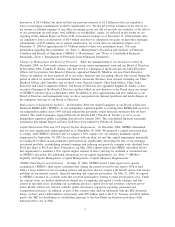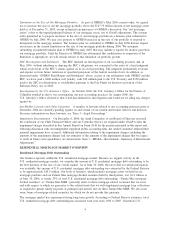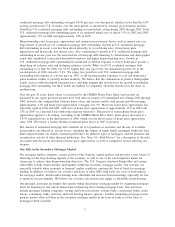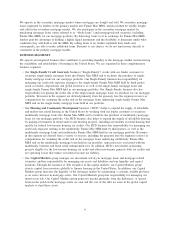Fannie Mae 2004 Annual Report Download - page 17
Download and view the complete annual report
Please find page 17 of the 2004 Fannie Mae annual report below. You can navigate through the pages in the report by either clicking on the pages listed below, or by using the keyword search tool below to find specific information within the annual report.TBA Market
The TBA, or “to be announced,” securities market is a forward, or delayed delivery, market for 30-year and
15-year fixed-rate single-family mortgage-related securities issued by us and other agency issuers. Most of our
single-class single-family Fannie Mae MBS are sold by lenders in the TBA market. Lenders use the TBA
market both to purchase and sell Fannie Mae MBS.
A TBA trade represents a forward contract for the purchase or sale of single-family mortgage-related securities
to be delivered on a specified future date. In a typical TBA trade, the specific mortgage pools that will be
delivered to fulfill the forward contract are unknown at the time of the trade. Parties to a TBA trade agree
upon the issuer, coupon, price, product type, amount of securities and settlement date for delivery. Settlement
for TBA trades is standardized to occur on one specific day each month. The mortgage-related securities that
ultimately will be delivered, and the loans backing those mortgage-related securities, frequently have not been
created or originated at the time of the TBA trade, even though a price for the securities is agreed to at that
time. Some trades are stipulated trades, in which the buyer and seller agree on specific characteristics of the
mortgage loans underlying the mortgage-related securities to be delivered (such as loan age, loan size or
geographic area of the loan). Some other transactions are specified trades, in which the buyer and seller
identify the actual mortgage pool to be traded (specifying the pool or CUSIP number). These specified trades
typically involve existing, seasoned TBA-eligible securities issued in the market. TBA sales enable originating
mortgage lenders to hedge their interest rate risk and efficiently lock in interest rates for mortgage loan
applicants throughout the loan origination process. The TBA market lowers transaction costs, increases
liquidity and facilitates efficient settlement of sales and purchases of mortgage-related securities.
Credit Risk Management
Our Single-Family business bears the credit risk of borrowers defaulting on their payments of principal and
interest on the single-family mortgage loans that back our guaranteed Fannie Mae MBS, including Fannie Mae
MBS held in our mortgage portfolio. In addition, Single-Family bears the credit risk associated with the
single-family whole mortgage loans held in our mortgage portfolio. The Single-Family business receives a
guaranty fee in return for bearing the credit risk on guaranteed single-family Fannie Mae MBS, including
Fannie Mae MBS held in our mortgage portfolio. In return for bearing credit risk on the single-family whole
mortgage loans held in our mortgage portfolio, Single-Family is allocated fees from the Capital Markets group
comparable to the guaranty fees that Single-Family receives on guaranteed Fannie Mae MBS. As a result, in
our segment reporting, the expenses of the Capital Markets group include the transfer cost of the guaranty fees
and related fees allocated to Single-Family, and the revenues of Single-Family include the guaranty fees and
related fees received from the Capital Markets group.
The credit risk associated with a single-family mortgage loan is largely determined by the creditworthiness of
the borrower, the nature and terms of the loan, the type of property securing the loan, the ratio of the unpaid
principal amount of the loan to the value of the property that serves as collateral for the loan (the
“loan-to-value ratio” or “LTV ratio”) and general economic conditions, including employment levels and the
rate of increases or decreases in home prices. We actively manage, on an aggregate basis, the extent and
nature of the credit risk we bear, with the objective of ensuring that we are adequately compensated for the
credit risk we take, consistent with our mission goals. For a description of our methods for managing mortgage
credit risk and a description of the credit characteristics of our single-family mortgage credit book of business,
refer to “Item 7—MD&A—Risk Management—Credit Risk Management.” Refer to “Item 1A—Risk Factors”
for a description of the risks associated with our management of credit risk.
Our Single-Family business is also responsible for managing the credit risk to our business posed by defaults
by most of our institutional counterparties, such as our mortgage insurance providers and mortgage servicers.
See “Item 7—MD&A—Risk Management—Credit Risk Management” for a description of our methods for
managing institutional counterparty credit risk and “Item 1A—Risk Factors” for a description of the risks
associated with our management of credit risk.
12
























